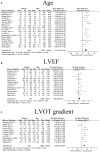Is There a Sex Difference in the Prognosis of Hypertrophic Cardiomyopathy? A Systematic Review and Meta-Analysis
- PMID: 37232242
- PMCID: PMC10381980
- DOI: 10.1161/JAHA.122.026270
Is There a Sex Difference in the Prognosis of Hypertrophic Cardiomyopathy? A Systematic Review and Meta-Analysis
Abstract
Background It is still unclear whether there is a sex difference in the prognosis of patients with hypertrophic cardiomyopathy (HCM). Therefore, we performed a meta-analysis to elucidate the association between sex and adverse outcomes in patients with HCM. Methods and Results The PubMed, Cochrane Library, and Embase databases were used to search for studies on sex differences in prognosis in patients with HCM up to August 17, 2021. Summary effect sizes were calculated using a random effects model. The protocol was registered in PROSPERO (International prospective register of systematic reviews) (registration number- CRD42021262053). A total of 27 cohorts involving 42 365 patients with HCM were included. Compared with male subjects, female subjects had a higher age at onset (mean difference=5.61 [95% CI, 4.03-7.19]), a higher left ventricular ejection fraction (standard mean difference=0.09 [95% CI, 0.02-0.15]) and a higher left ventricular outflow tract gradient (standard mean difference=0.23 [95% CI, 0.18-0.29]). The results showed that compared with male subjects with HCM, female subjects had higher risks of HCM-related events (risk ratio [RR]=1.61 [95% CI, 1.33-1.94], I2=49%), major cardiovascular events (RR=3.59 [95% CI, 2.26-5.71], I2=0%), HCM-related death (RR=1.57 [95% CI, 1.34-1.82], I2=0%), cardiovascular death (RR=1.55 [95% CI, 1.05-2.28], I2=58%), noncardiovascular death (RR=1.77 [95% CI, 1.46-2.13], I2=0%) and all-cause mortality (RR=1.43 [95% CI, 1.09-1.87], I2=95%), but not atrial fibrillation (RR=1.13 [95% CI, 0.95-1.35], I2=5%), ventricular arrhythmia (RR=0.88 [95% CI, 0.71-1.10], I2=0%), sudden cardiac death (RR=1.04 [95% CI, 0.75-1.42], I2=38%) or composite end point (RR=1.24 [95% CI, 0.96-1.60], I2=85%). Conclusions Based on current evidence, our results show significant sex-specific differences in the prognosis of HCM. Future guidelines may emphasize the use of a sex-specific risk assessment for the diagnosis and management of HCM.
Keywords: hypertrophic cardiomyopathy; meta‐analysis; prognosis; sex.
Figures




Similar articles
-
A systematic review and meta-analysis of sex differences in clinical outcomes of hypertrophic cardiomyopathy.Front Cardiovasc Med. 2023 Dec 5;10:1252266. doi: 10.3389/fcvm.2023.1252266. eCollection 2023. Front Cardiovasc Med. 2023. PMID: 38116536 Free PMC article. Review.
-
Clinical Outcomes in Patients With Nonobstructive, Labile, and Obstructive Hypertrophic Cardiomyopathy.J Am Heart Assoc. 2018 Feb 25;7(5):e006657. doi: 10.1161/JAHA.117.006657. J Am Heart Assoc. 2018. PMID: 29478967 Free PMC article.
-
Prognostic impact of atrial fibrillation in hypertrophic cardiomyopathy: a systematic review.Clin Res Cardiol. 2021 Apr;110(4):544-554. doi: 10.1007/s00392-020-01730-w. Epub 2020 Sep 3. Clin Res Cardiol. 2021. PMID: 32880676
-
Left Ventricular Systolic Dysfunction in Patients Diagnosed With Hypertrophic Cardiomyopathy During Childhood: Insights From the SHaRe Registry.Circulation. 2023 Aug;148(5):394-404. doi: 10.1161/CIRCULATIONAHA.122.062517. Epub 2023 May 25. Circulation. 2023. PMID: 37226762 Free PMC article.
-
Age-related sex differences in the outcomes of patients with hypertrophic cardiomyopathy.PLoS One. 2022 Feb 25;17(2):e0264580. doi: 10.1371/journal.pone.0264580. eCollection 2022. PLoS One. 2022. PMID: 35213653 Free PMC article.
Cited by
-
Sex-Associated Differences in Clinical Outcomes After Septal Reduction Therapies in Hypertrophic Cardiomyopathy.Mayo Clin Proc. 2024 Dec;99(12):1933-1944. doi: 10.1016/j.mayocp.2024.05.026. Epub 2024 Nov 12. Mayo Clin Proc. 2024. PMID: 39530964
-
Emerging risk factors for heart failure in younger populations: A growing public health concern.World J Cardiol. 2025 Apr 26;17(4):104717. doi: 10.4330/wjc.v17.i4.104717. World J Cardiol. 2025. PMID: 40308622 Free PMC article. Review.
-
The clinical utility of cardiac myosin inhibitors for the management of hypertrophic cardiomyopathy: a scoping review.Heart Fail Rev. 2025 Mar;30(2):453-467. doi: 10.1007/s10741-024-10476-w. Epub 2024 Dec 17. Heart Fail Rev. 2025. PMID: 39690360 Free PMC article.
-
Sex-Related Differences in Patients With Hypertrophic Cardiomyopathy Undergoing Alcohol Septal Ablation.J Am Heart Assoc. 2024 May 7;13(9):e032553. doi: 10.1161/JAHA.123.032553. Epub 2024 May 3. J Am Heart Assoc. 2024. PMID: 38700034 Free PMC article.
-
A systematic review and meta-analysis of sex differences in clinical outcomes of hypertrophic cardiomyopathy.Front Cardiovasc Med. 2023 Dec 5;10:1252266. doi: 10.3389/fcvm.2023.1252266. eCollection 2023. Front Cardiovasc Med. 2023. PMID: 38116536 Free PMC article. Review.
References
-
- Wigle ED, Rakowski H, Kimball BP, Williams WG. Hypertrophic cardiomyopathy: clinical spectrum and treatment. Circulation. 1995;92:1680–1692. - PubMed
-
- Elliott PM, Poloniecki J, Dickie S, Sharma S, Monserrat L, Varnava A, Mahon NG, McKenna WJ. Sudden death in hypertrophic cardiomyopathy: identification of high risk patients. J Am Coll Cardiol. 2000;36:2212–2218. - PubMed
-
- Ho CY, Day SM, Ashley EA, Michels M, Pereira AC, Jacoby D, Cirino AL, Fox JC, Lakdawala NK, Ware JS, et al. Genotype and lifetime burden of disease in hypertrophic cardiomyopathy: insights from the Sarcomeric Human Cardiomyopathy Registry (SHaRe). Circulation. 2018;138:1387–1398. doi: 10.1161/circulationaha.117.033200 - DOI - PMC - PubMed
Publication types
MeSH terms
LinkOut - more resources
Full Text Sources

